Written by Helga George and published on https://gardenerspath.com/
Apple trees are perhaps one of the most popular fruit trees to grow in the home garden, but are among the most prone to disease and problems as well. But, if you are aware of the most common growing problems, you can take steps to keep them away from your apple tree and the fruit, which means you can enjoy more and better apples from your trees.
Fortunately, it is easy to identify if your apple tree is suffering from an infection. Identification is the first step in helping your apple tree battle against infection, and recover quickly to become healthy again. To help you identify what disease is affecting your apple tree here is a list of the four most common diseases that can help you figure out what to do if you notice your plant showing symptoms of an ailment:
HOW TO IDENTIFY, TREAT, AND PREVENT COMMON APPLE DISEASES
If you’ve ever seen apple trees growing in the wild, you may already know they are privy to a wide range of diseases. But what about homegrown apples?
An apple enjoyed fresh off the tree is delectable, but you may have to work hard for your shiny piece of fruit.
Many different types of fungi and some varieties of bacteria can cause infections in a home garden.
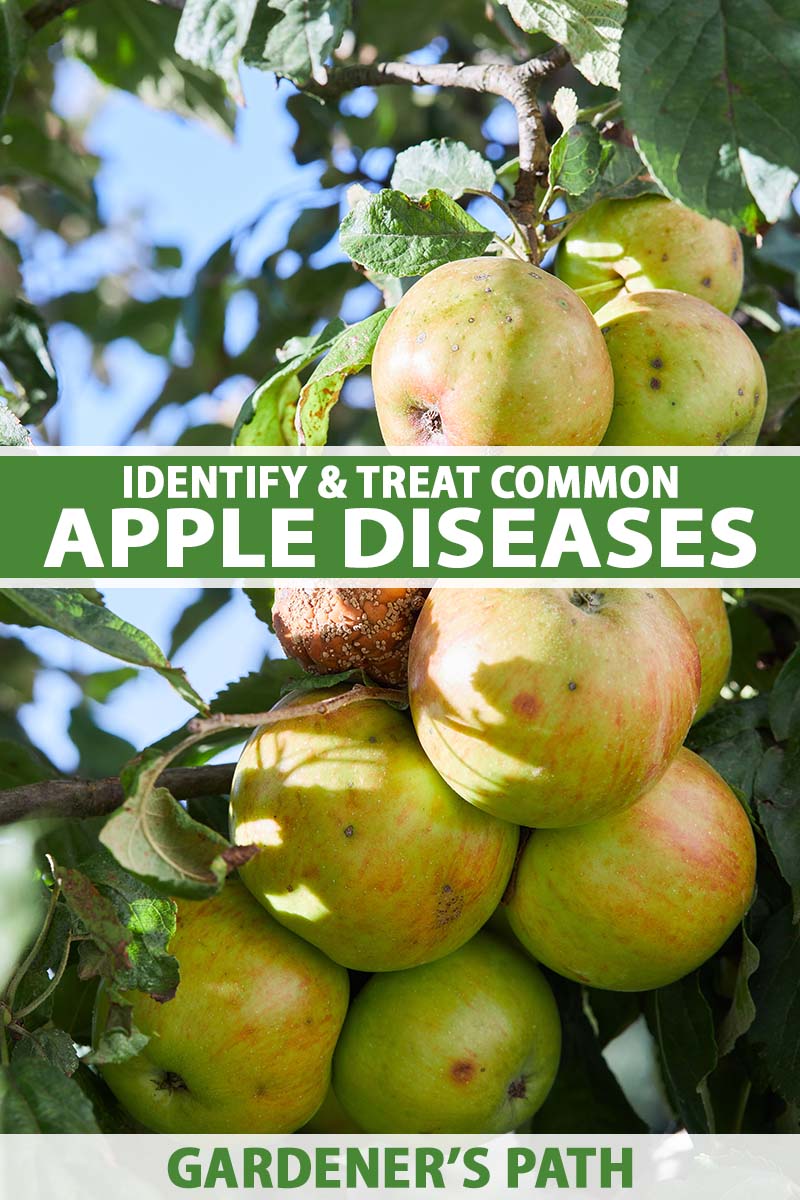
Your best bet to prevent the onset of disease is to plant varieties that are resistant to the major pathogens in your area.
Of course, this advice won’t do much good if you already have an apple tree, or if symptoms are actually due to a physiological problem like a nutrient deficiency rather than an infectious ailment.
In this guide, we’ll cover the most common apple diseases, how to identify them, and what action to take.
Common Apple Diseases
- Bacterial Infections
- Crown Gall
- Fire Blight
- Fungal and Water Mold Infections
- Anthracnose Canker and Bull’s-Eye Rot
- Apple Scab
- Armillaria Root Rot
- Frogeye Leaf Spot and Black Rot
- Phytophthora Crown Rot, Collar Rot, and Root Rot
- Powdery Mildew
- Rust
- Sooty Blotch and Flyspeck
- Southern Blight
- White Rot (aka Bot Rot)
- Viral Infections
- Flat Apple Disease
- Physiological Disorders
- Bitter Pit
- Chlorosis
- Cork Spot
- Soggy Breakdown
- Sunscald
- How to Prevent Disease in Your Apple Trees
- Practice Good Hygiene in the Fall
- Sterilize Your Pruning Shears Between Cuts
- Practice Good Water Management When Planting
Bacterial Infections
There are two very serious apple diseases caused by bacteria.
One is the generally fatal crown gall. The other is the highly contagious fire blight. This is a key disease to be aware of, so that you can strike quickly at the first sign of infection and have some chance of containing its spread.
Crown Gall
This unusual disease affects a wide array of plants, and the bacteria that cause it may be found in soils throughout the world.
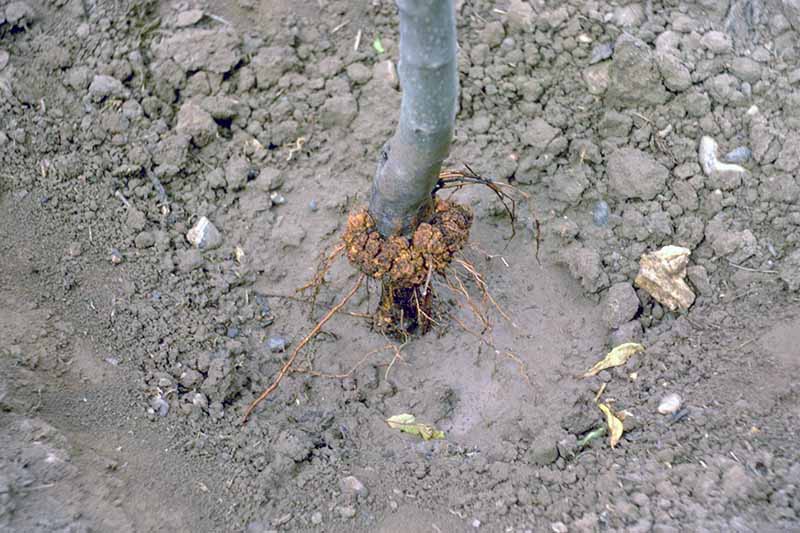
The causal agent is Rhizobium rhizogenes (aka Agrobacterium tumefaciens). This species of bacteria genetically engineers plants naturally by changing the plant’s DNA causing it to produce characteristic galls, which are a type of tumor.
Woolly apple aphids also cause the production of galls, but you can tell the difference because crown galls are not hidden in white cottony wax.
Unfortunately, crown gall on apples is usually fatal.
Fire Blight
Does your apple tree look like someone set fire to its tips? If so, the tree may be infected with fire blight bacteria (Erwinia amylovora).
This disease is the most severe on new shoots but can rapidly spread to all parts of the tree above ground.

The weather greatly affects the spread of this disease. Rain and high humidity cause it to spread rapidly, and it is particularly severe in temperatures between 75 and 85°F.
When these conditions occur, you should discontinue overhead irrigation, if using, to try and reduce the amount of moisture on the foliage.
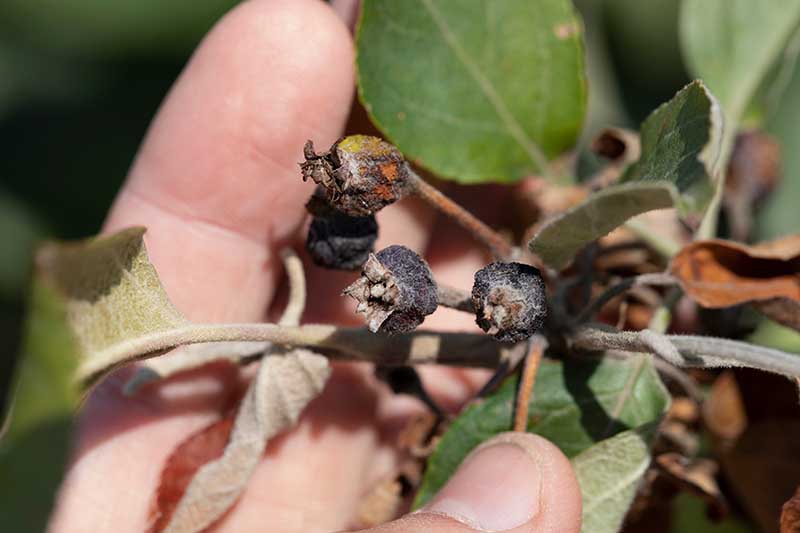
Pruning can go a long way toward controlling this disease. You can also spray with copper to treat it, but be careful. Too much copper can damage the fruit or cause the bacteria to become resistant.
Fungal and Water Mold Infections
Unfortunately, apple trees are susceptible to many different fungal pathogens.
And to make things worse, they are also prone to infections by water molds – insidious fungal-like organisms that live in the soil and thrive under moist conditions.
We will cover the main pathogens in this category to help you diagnose and treat your trees.
Anthracnose Canker and Bull’s-Eye Rot
Anthracnose canker is a severe disease that most commonly occurs in the Pacific Northwest region of the US. This disease is a problem throughout the world – from the UK to China.
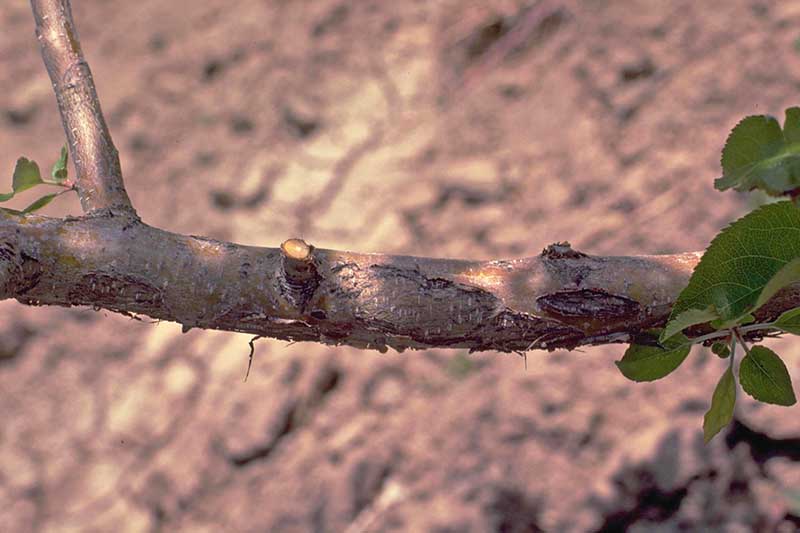
It is caused by different species of Neofabraea fungi (N. malicorticis and N. alba) that produce apple tree cankers that can lead to a fruit infection known as bull’s-eye fruit rot.
The canker phase is considered the most serious, and these can severely damage trees. Commercial growers sometimes have to replace entire orchard blocks to prevent its spread.
The cankers mature in about a year and start producing spores, which infect the fruit and lead to bull’s-eye rot.
You should prune out the cankers, remove stems or even entire trees with heavy canker infections, and burn all affected plant material if this is permitted in your area. Since it can be hard to spot all of the cankers, you should also apply fungicide treatments.
The spores from anthracnose canker can infect the fruit at any point after bloom and throughout the growing season.
Unfortunately, the fruit infections on the tree are latent – or in other words, not detectable – and are only observed post-harvest, about four to seven months after the fruit have been put in storage.
When Neofabraea infect the fruit, they can cause distinct symptoms. N. alba becomes a soft rot with white mycelia, whereas N. malicorticis produces sunken, circular, brown lesions.
To control bull’s-eye rot, you should apply fungicides before the autumn rains, at petal fall, and pre-harvest.
Apple Scab
This serious fungal disease caused by Venturia inaequalis first manifests as small lesions on the bottoms of the leaves in the spring.
From there, it spreads to the tops of the leaves and then to the fruit where it exhibits like little brown scabs.
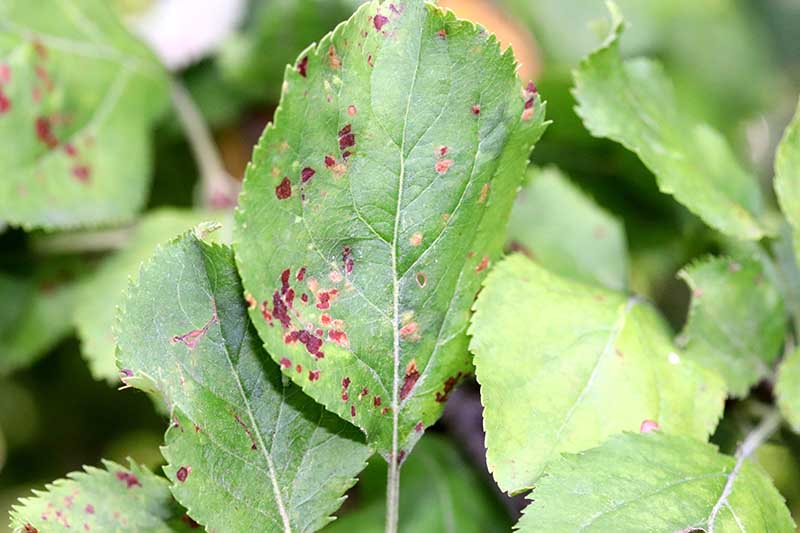
Apple scab can result in total foliage loss by midsummer, which then makes the tree susceptible to other diseases.
While spraying with fungicides in the early spring can help prevent infestations, this fungus is difficult to control. Be sure to bag up the previous year’s leaves and fruit to prevent the disease from spreading.
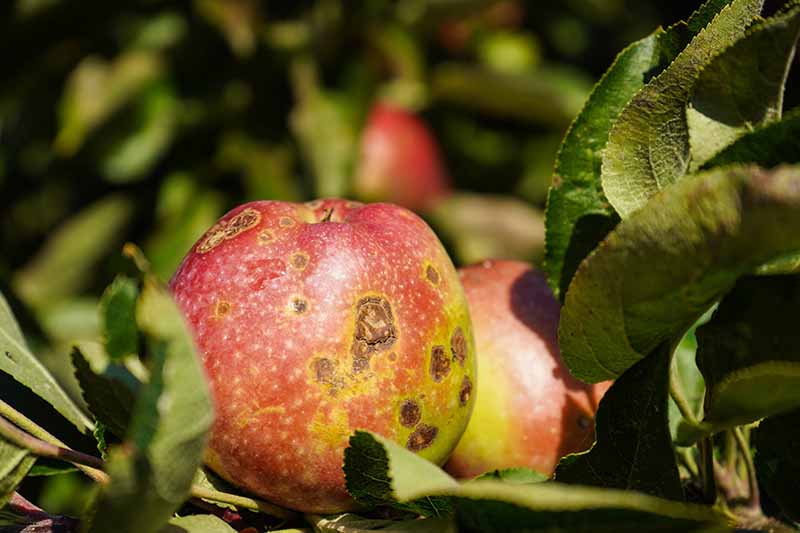
Your best bet to avoid this fungal disease is to plant resistant varieties. These include ‘Enterprise,’ ‘Jonafree,’ ‘Liberty,’ ‘Pristine,’ and ‘Williams Pride.’
Unfortunately, ‘Cortland,’ ‘McIntosh,’ ‘Red Delicious,’ and ‘Rome Beauty’ are all susceptible.
Armillaria Root Rot
In addition to being a fatal pathogen of a large number of trees, shrubs, and woody vines, the claim to fame of Armillaria mellea, the honey mushroom, is that it is the largest organism known worldwide.
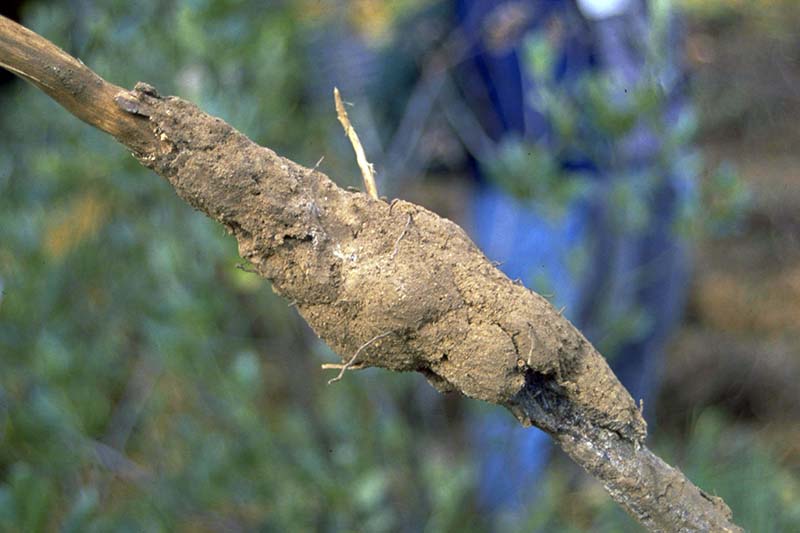
A colony in Oregon spreads for almost two and a half miles. This species is one of several that have been associated with root rot in eastern deciduous forests.
The wide host range of this fungus bodes poorly for apple trees because fungal inoculum infests small pieces of wood in the soil in the form of mycelia, and these can go on to infect apples.
Infected apple trees have reduced terminal shoot growth, and their leaves may turn purple in the fall much earlier than those of healthy trees. And then there is the symptom that is impossible to miss – the sudden collapse of diseased trees in midsummer.
Mushrooms may also form at the base of infected trees in late summer or fall.
There is no way to treat an apple tree that is infected with Armillaria. As with so many other fungal pathogens, prevention is the only way to avoid this fungus.
It is probably small solace that honey mushrooms are delicious and safe to eat.
Frogeye Leaf Spot and Black Rot
These two diseases are caused by the same fungus, Physalospora obtusa (syn. Botryosphaeria obtusa), but at different points in its life cycle.
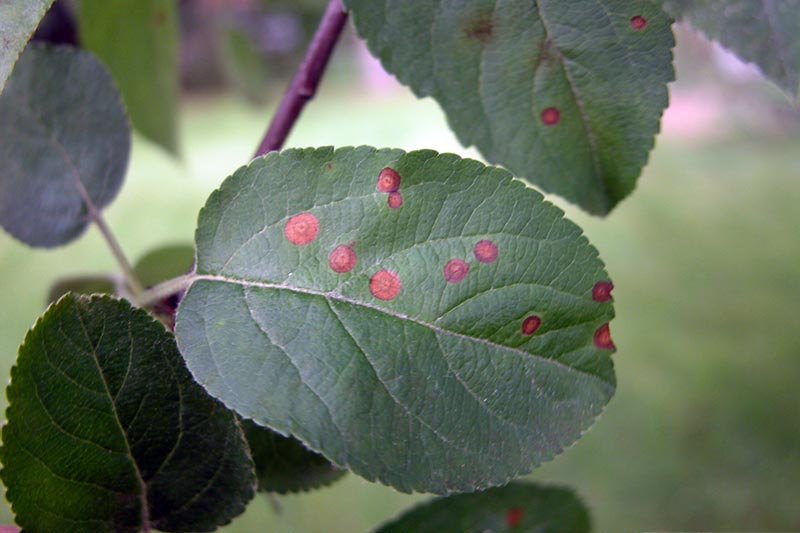
Brown spots on the flower ends of the fruit are the first sign of infection. These spots will grow into concentric circles and rot the fruit.
The tree’s leaves may develop small holes or purplish brown spots that look like a frog’s eyes. At this point, the disease is known as frogeye leaf spot. Eventually the disease spreads to the limbs and kills the tree by forming cankers – at this point it is known as black rot.
You should immediately prune all the infected parts of the tree and either burn or get rid of them as quickly as possible. You may spray with sulfur or an appropriate fungicide in the early stages of the disease.
However, by the time you notice the signs of an infection, it might be too late for fungicides to make a difference.
Phytophthora Crown Rot, Collar Rot, and Root Rot
These diseases are among the most serious ones that affect apples.
They are caused by various species of Phytophthora – close cousins to the organism that caused the Irish potato famine. While once thought to be fungi, these pathogens are now known as oomycetes, or water molds.
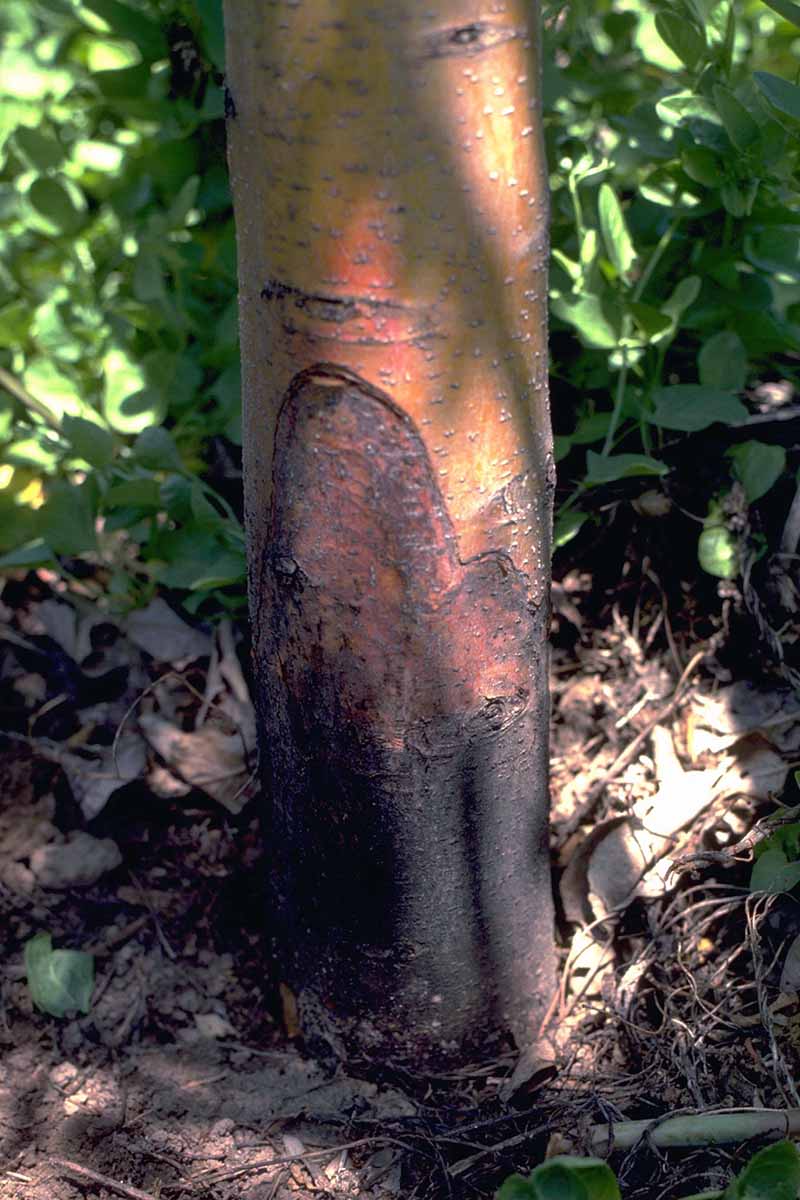
The symptoms of a Phytophthora infection on apples can be difficult to distinguish from other problems. The tree may be noticeably less vigorous, and the leaves may turn yellow.
This group of diseases can affect different parts of the trees. The crown is the point where the roots meet the stem, and if that is infected, the disease is called crown rot.
Collar rot takes place at the trunk’s scion portions. In the most serious cases, the roots will rot.
Infected trees will probably die, either over a long period, or sometimes even in the same year they become infected – particularly if it is an unusually wet year.
Once the soil is infected, it will stay that way. You will be unable to replant apples in an area that has this type of pathogen present.
On the bright side, you have some hope of saving your tree if you catch the disease early enough. You can spray the root zone with mefenoxam or metalaxyl.
Planning ahead and practicing good water management when you plant your trees can help to prevent their loss from these diseases. For example, be sure that you plant them in soil that drains well and avoid overwatering.
Powdery Mildew
Many types of powdery mildew pathogens exist, all specialized for different plants. Apple has its own type – Podosphaera leucotricha.
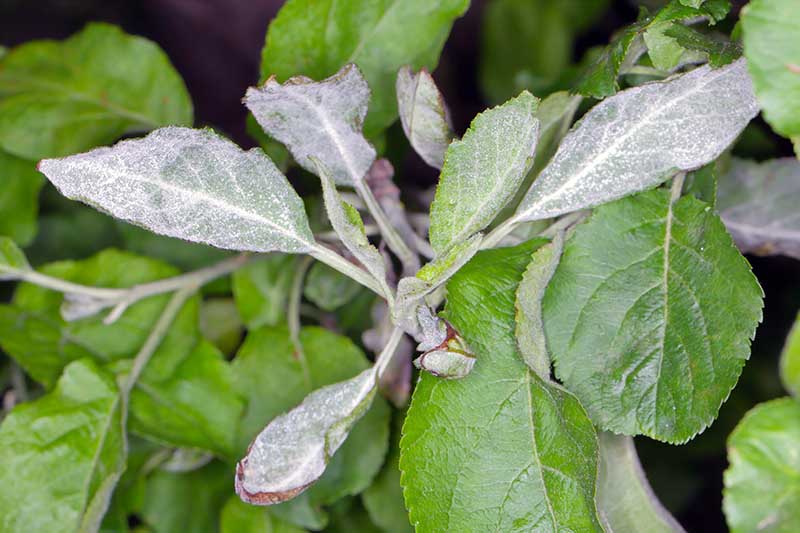
The classic symptom of powdery mildew is white growth on the underside of the leaves that looks like felt. As the disease gets worse, the tree’s growth will be stunted. Its foliage will wilt, and the leaves and twigs will become covered with specks that look like black pinpoints.
Trees are more resistant to this disease if they are planted in full sun and have enough space around them for air to circulate well.
If your tree is showing symptoms, prune any shoots that are white in the early spring and destroy them. And make sure you disinfect your pruning shears afterwards.
If powdery mildew is a common problem in your area, you can spray with sulfur or a fungicide in the early spring.
An updated version of the classic Bordeaux mix commonly used to treat powdery mildew is available from Arbico Organics.
Rust
If your tree has orange or yellow spots on its leaves and fruit that is mottled or distorted, you are probably dealing with rust.
The most common type of rust on apples is cedar apple rust caused by the fungus Gymnosporangium juniperi-virginianae.
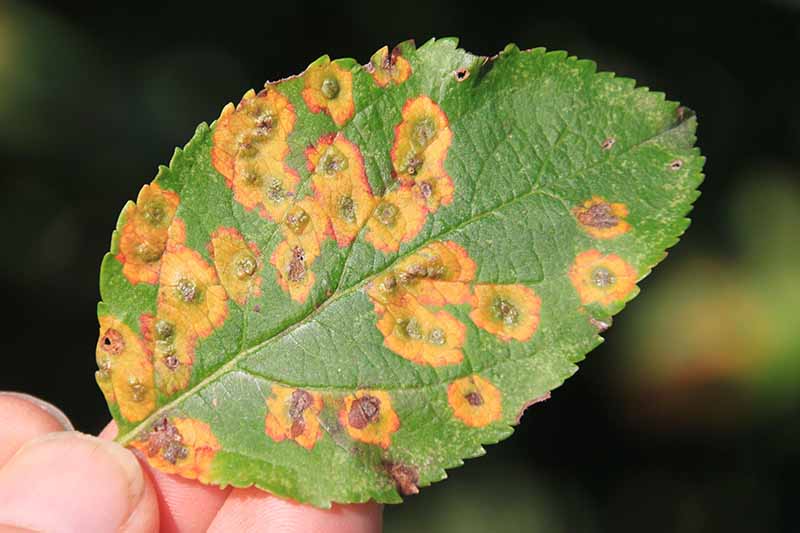
The diseases known as rusts are caused by complicated fungi. They live on another kind of plant before they spread to their final host – apples in this case.
Their alternate host is a kind of juniper known commonly as eastern red cedar.
Getting rid of eastern red cedar plants on or near your property will help prevent this disease. However, the spores can travel for miles, so that may not be feasible.
You can spray weekly with fungicide or sulfur to prevent cedar apple rust if you know that the fungus is active in your area.
Sooty Blotch and Flyspeck
These are two different types of disease that frequently occur together on the same near-mature fruit.
While all varieties are susceptible to both types of disease, yellow varieties exhibit the most severe symptoms.
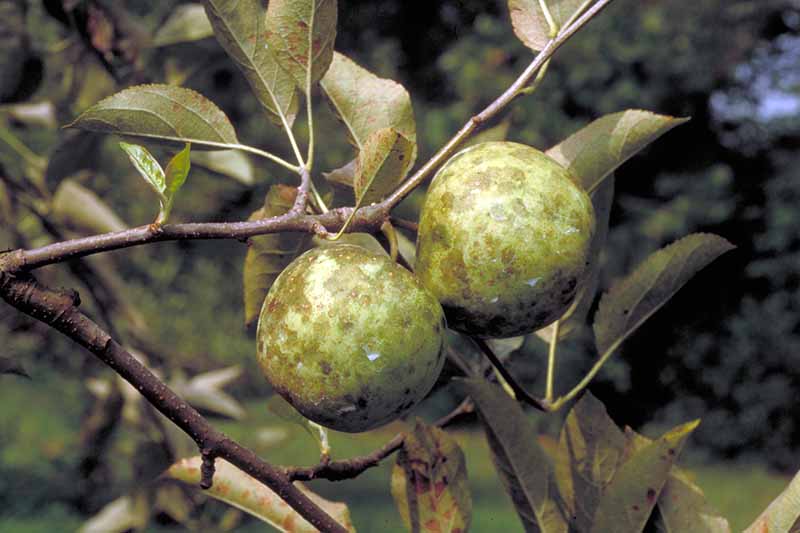
The fungal pathogens involved do not severely damage the fruit. It is still edible, but less valuable in the marketplace and difficult to sell, so it can be a major problem for commercial growers.
Sooty blotch, caused by a large number of different fungal species, produces symptoms that you would expect from its name.
The blotches may be one-quarter inch in diameter or larger and may cover almost the whole fruit. You can often rub off the blotches, but commercial growers may need to resort to bleaching if the fruit are infected early in the season.
Flyspeck, caused by Zygophiala jamaicensis fungi, also produces symptoms that are reflected in its name. As many as 50 or more shiny black dots may appear on the surface of the fruit. These are more difficult to rub off than sooty blotches.
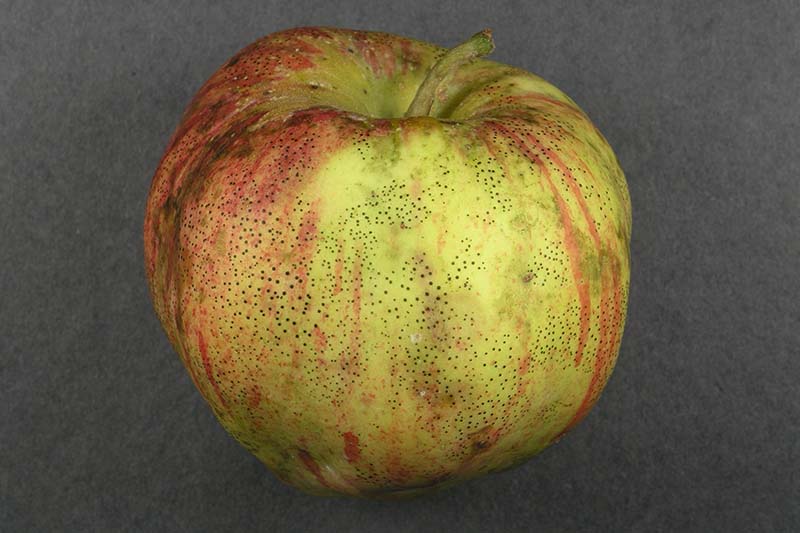
Both diseases tend to occur in damp shady areas of an orchard. Opening up the trees to allow greater air movement will help to control these diseases.
Fortunately backyard gardeners do not need to worry much about sooty blotch or flyspeck. The fruit will be fine to eat if it is washed, rubbed, or peeled first.
Southern Blight
The fungus Sclerotium rolfsii can infect several hundred species of plants, and unfortunately apple trees are among them.
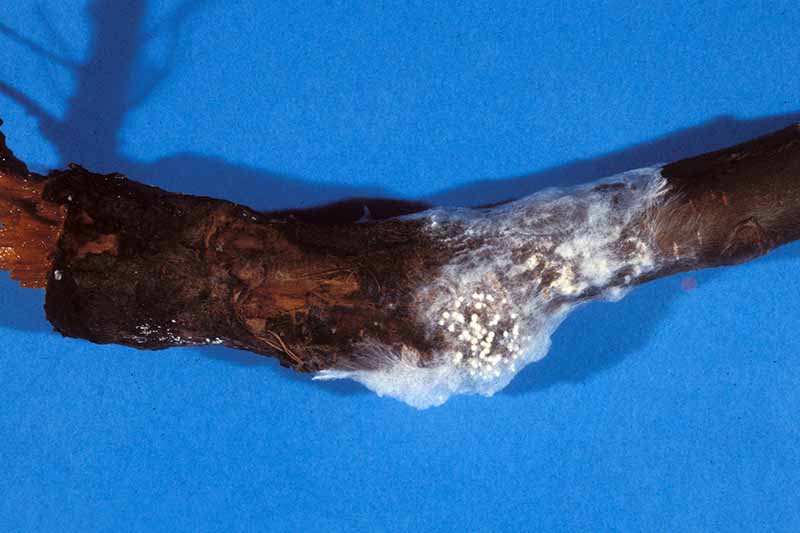
It typically strikes in the southeastern part of the US and manifests as a weblike white mycelium that often grows on the bases and lower parts of the trunks of infected trees.
Regrettably, this disease is fatal and usually rapidly kills infected trees. Fortunately apple trees become resistant to southern blight as they age, and those that are most severely affected are typically one to three years old.
The best you can hope for is to prevent this nasty disease when trees are young. Don’t plant in locations where southern blight has been known to be severe on previous crops.
And purge organic material from around the base of the tree, since it can serve as food for the pathogen.
White Rot (aka Bot Rot)
White rot is also known as bot rot, named for the pathogen that causes it, Botryosphaeria dothidea.
For a nice change of pace, the causal agent of this disease is a relatively weak pathogen and infection only becomes a problem when the tree is stressed.

However, if it does infect a tree, fruit losses can be heavy. New infections become visible in early summer, and cankers form on the tree.
It can be difficult to tell them apart from black rot cankers, so you may need to have samples of your infected tree tested at a local agricultural agency to determine which fungus is causing the disease.
Two types of fruit rot can develop. The primary one affects the external surface and manifests as slightly sunken brown spots that may have a red halo around them. If this infection progresses, the entire fruit can rot. The name white rot comes from the second type, fruit that can bleach as they decay and turn light brown.
Since it only occurs when the trees are stressed, management includes minimizing stressors like winter injury, water stress, insect damage, and other types of disease.
Also prune any dead wood on the tree, so the fungus can’t grow on it. Be sure and remove any mummified fruit because they are a tremendous source of spores.
Viral Infections
There is no known cure for apple trees infected with viruses. Therefore, it is of paramount importance to carefully select rootstocks and scion buds that are uninfected.
Most viruses are spread by grafting, so if you already have a tree, there is not much you can do to prevent potential viral infections.
Another thing to keep in mind is that if you live in an area where nematodes may spread apple viruses, you should have your soil tested for these pests. If they are present, you should choose cultivars and rootstocks that are tolerant – or even better, resistant – to viruses.
You will also want to control weeds and limit moving the soil around, so you don’t inadvertently spread an infection.
Common viral diseases spread by nematodes include the cherry rasp leaf virus (CRLV), which is described below, tobacco ringspot virus, and tomato ringspot virus, which causes apple union necrosis.
Flat Apple Disease
The virus that causes this disease, known commonly as cherry rasp leaf virus or CRLV, is found in the western US and British Columbia.
However, experts are concerned that it could spread to growing regions in the northeast and strongly suggest using caution when buying trees, scion buds, or young plants from operations in western states.
CRLV readily infects a large number of common orchard weeds, and dagger nematodes (Xiphinema americanum) can spread it between trees, both apple and cherry. One good thing is that nematodes move very slowly, so it takes a while for this disease to spread.
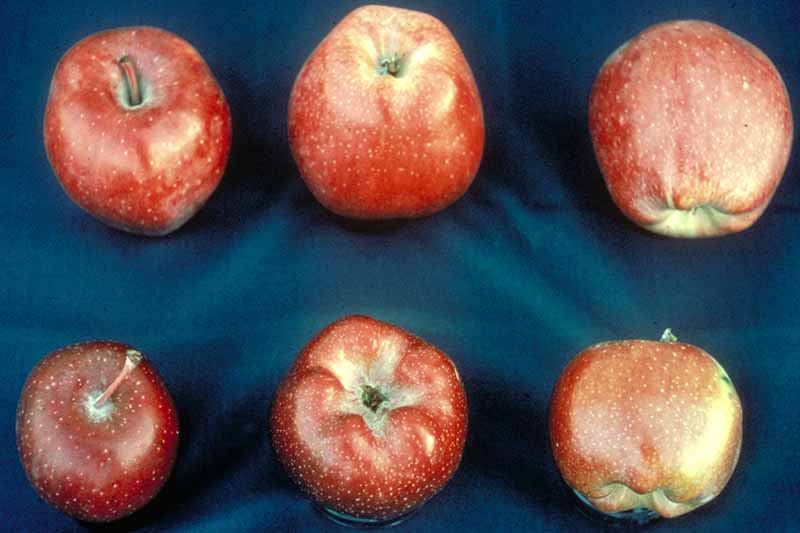
You can tell that your plants have this disease when the fruit becomes flattened from both sides. Another symptom you may or may not note is leaves that roll up from the midrib.
As with other apple viruses, there is no available control or cure for this disease. As soon as you discover that your tree is infected with this pathogen, you should remove it.
Physiological Disorders
Many disorders that appear to be diseases are actually due to problems with the tree or fruit physiology instead, with no active pathogen involved.
A number of factors can disrupt apple production. One common cause is a lack of nutrients due to unfavorable soil pH. We’ll briefly break these disorders down according to their symptoms here.
Bitter Pit
The first symptom of bitter pit is small, water-soaked lesions on the fruit. These spots will gradually change to look like bruises and will eventually become sunken.

Even though the fruits show symptoms while on the tree, they will not become bitter until after harvest.
This is one physiological condition that is not due to soil pH. It appears to happen when calcium becomes concentrated in the leaves rather than the fruit.
A hot and dry climate can increase the chances that the fruit will develop bitter pit. The leaves transpire more in a climate such as that of New Mexico, and the calcium diverts to the leaves.
There is no control available once the fruit develops symptoms. Your best bet is to avoid excessive use of nitrogen and potassium fertilizer, which can cause the tree to grow an abundance of foliage at the expense of fruit.
You may also be able to prevent this issue by spraying it with calcium chloride or calcium nitrate over the summer.
Chlorosis
Many types of insects and diseases can cause apple leaves to become discolored, a condition known as chlorosis.
If the yellowing occurs throughout the leaves of your tree and is not limited to small patches of yellow color, your tree may be deficient in iron.
The symptoms of this physiological issue include yellowing and even the dying off of leaves. A classic indicator is that the veins stay green while the foliage around them turns yellow. This happens first to young leaves but can spread to the whole tree.
The problem may not be that your soil lacks iron, but rather, it could be that the pH is too high. This is a particular problem with soils rich in lime like those in New Mexico.
One way to solve this problem is to add chelated iron, although this is just a temporary fix.
You may also see symptoms similar to those of chlorosis due to iron deficiency when the problem is actually due to a lack of adequate manganese levels.
A soil test can help you to figure out which specific deficiency your tree is suffering from.
To solve this condition, you can either use an acid-forming nitrogen fertilizer, or apply a foliar spray of manganese sulfate in April, according to the results of your soil test.
Cork Spot
If your apples look like they have insect or hail damage, be sure to look more closely. A disorder called cork spot manifests with these symptoms.
These spots may progress from being small dimples to half-inch-wide corky or soft spots.
Instead of being caused by an organism, these spots are the result of low soil pH that leads to a deficiency of calcium.
This disorder is curable. You can add lime to your soil if the pH is below 6.0. Another thing you can do is spray the trees with calcium chloride every ten days until you have harvested all your apples.
Soggy Breakdown
Many people keep their fruit cool during storage to prolong the shelf life of their harvest. However, storage at temperatures that are too cold can result in chilling injury.
One such disorder is soggy breakdown, common in ‘Honeycrisp’ apples, in which the flesh can develop brown rings.
Keeping the fruit at temperatures above 2ºC (about 36ºF) can minimize the development of symptoms.
Sunscald
Just like people, fruit can become sunburned. The first indication that your fruit are being scalded is when the skin develops yellow or flushed areas.
These areas will turn dark while the fruit is still on the tree. You should avoid these fruit when you harvest, because it will not store well. Since this condition is not due to an infectious organism, you can dispose of it on your compost pile.

In addition to large areas of the fruit turning yellow, this disorder can appear first as small yellow spots. However, it is easy to miss them. These spots become much worse when the harvested fruit are in storage.
You can manage sunscald with proper pruning or training. Some gardeners and farmers use overhead irrigation to cool the fruit, but that can lead to disease problems, so it may be best to avoid that process.
How to Prevent Disease in Your Apple Trees
Many apple pathogens spread slowly over the course of years and will not be noticeable until they overwhelm your tree.
Taking measures to prevent disease ahead of time can help to keep your apple trees healthy and disease-free.
Practice Good Hygiene in the Fall
Many of the apple diseases that you may face overwinter in leaves on the ground and fruit that has fallen from your tree.
It is critical that you remove, bag, and throw out these leaves and fruit. Doing this will greatly reduce the numbers of pathogens waiting to attack in the following spring.
And one more thing – absolutely do not add this debris to your compost pile!
Sterilize Your Pruning Shears Between Cuts
When you are pruning your tree, sterilize your pruning shears between each cut. If you don’t, you risk spreading disease throughout the tree or between trees.
You can sterilize your pruning shears using liquid solutions of 70-95 percent alcohol or 10-50 percent bleach.
This is particularly prudent if you are cutting back limbs damaged by fire blight, which is highly infectious.
Practice Good Water Management When Planting
Be sure to provide adequate drainage. Do not plant in areas that frequently flood, in low spots, or heavy soils.
Make sure the graft union is positioned well above the soil line.
It is critical to keep water from accumulating around the tree crowns, or your trees could contract a fatal Phytophthora disease.
Many Common Problems May Affect Apples
Apples are prone to more than their fair share of diseases, and physiological problems as well. But they’re still deliciously rewarding, once the harvest comes in.
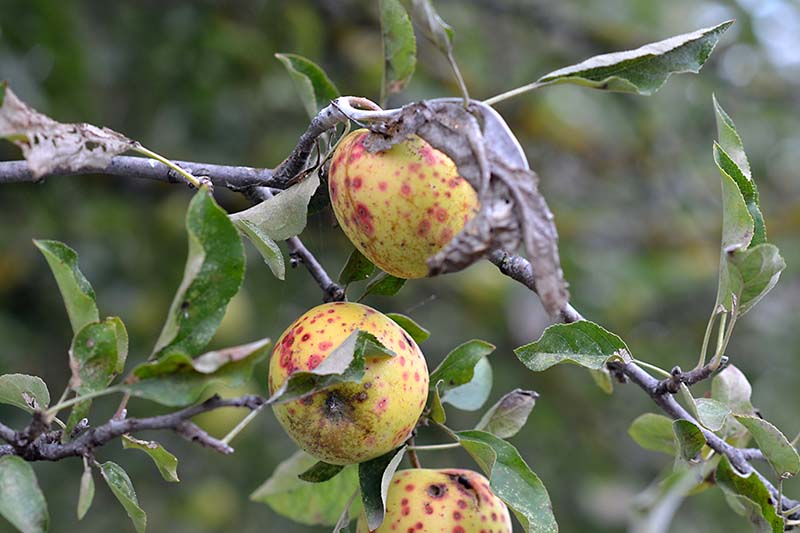
While it’s easy to say that you should plant resistant varieties, if you buy a house with an apple tree or two in its yard already, your trees may not be resistant to the local pathogens.
In this case, practicing good hygiene with leaves and fruit on the ground can go a long way to preventing some nasty issues, along with following best practices to maintain adequate airflow, keep an eye on drainage, and properly sanitize pruning tools.
You may have to rely on fungicides to cure your trees of the many types of fungi that can infect them. But the pathogens’ sensitivity to particular fungicides can vary around the country, so check with your local experts to see what to use to treat your trees.
Have you had success rescuing or resurrecting an infected apple tree? Or do you want to vent about a tree that you lost? Either way, we would love to hear your comments below.
Original post here https://ift.tt/3gsizdx.
from AAA Tree Lopping Ipswich https://ift.tt/3vaVRfa
via IFTTT
No comments:
Post a Comment